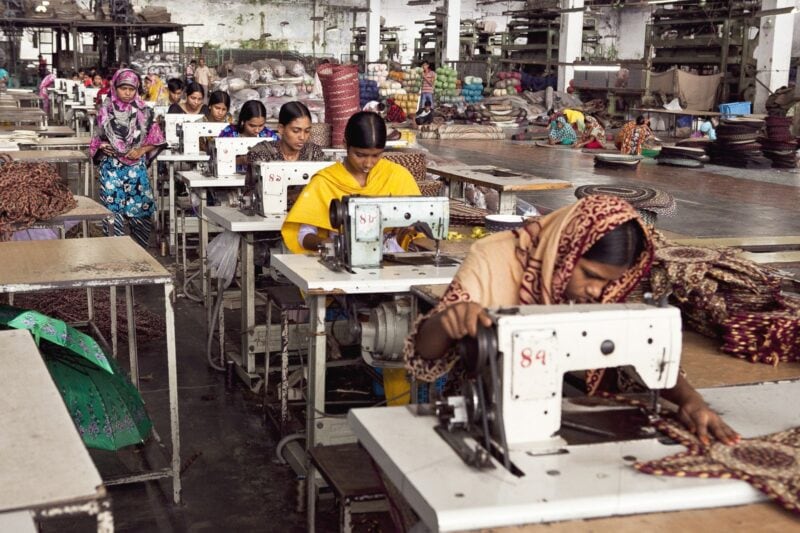
What is clear is that lots of fabric ends up getting wasted at various stages of the supply chain. This is more of a problem than ever, given all the cancelled orders as a result of the COVID-19 pandemic.
Digital deadstock
There are some brilliant online platforms selling deadstock fabric, like the UK-based Offset Warehouse, and Queen of Raw in the US.
But it has proved difficult to find fabric that ‘ticks all our boxes’ (i.e. plain colour 100% cotton fabric that resembles a sari in texture, in a range of vibrant colours, which has the appropriate safety certification) for a feasible cost.
Then a friend of mine who works in the garments sector told me about upcybom.com, which connects buyers and sellers of deadstock directly.
I was excited to discover some fabric that looked like exactly what we were after, at a price that we could afford. A Dhaka-based friend of mine kindly offered to go and check it out.
It turned out that the fabric was being sold in a dedicated ‘deadstock fabric market’ in Old Dhaka.

Deadstock fabric arriving at the local market in Old Dhaka

This is where lots of the fabric originally intended to be used in exported garments ends up
My friend’s visit to the market revealed two issues:
- The colours available looked quite different from how they appeared in the photos
- There was no safety testing certificate available
The fact that it would have already undergone safety testing was a key reason to use fabric that was originally intended to make garments to be sold in a Western market.
But because the fabric was now being sold within Bangladesh, even if it had been safety tested, there was no ‘paper trail’ available, as this isn’t how things operate locally.
So we would have to undertake the process ourselves.
Safety first
I’ve spent many, many hours researching safety standards, and been very fortunate to get brilliant pro-bono support from a product safety lawyer at DLA Piper, alongside guidance from Bureau Veritas, one of the world’s leading safety testing companies, who tested the first limited-edition collection of blankets I had made in London last summer.
I’ve learned that the most extensive – and expensive! – part of the safety testing process relates to confirming the lack of potentially hazardous chemicals in the fabric.
Colour is an important part of Khushi Kantha’s design aesthetic, in celebration of the vibrant colours that Bangladesh is renowned for.
But if we go ahead with our plan to use deadstock, and we source it from local markets in Bangladesh, we would be endlessly testing fabric.
The chemicals relate to the dyes, which means that every different colour fabric we used would have to be tested separately, on top of testing a sample of every batch of vintage saris that we used for the inside layers of the blankets. This would clearly get very expensive and complicated.
Desperately seeking secondhand saris

Some of the vintage saris we used for Khushi Kantha’s first, limited-edition collection, created last summer
Sourcing secondhand saris for the inside layers of the blankets has also been proving challenging – my friend ended up on a bit of a ‘wild goose chase’ round the markets of Dhaka, trying to locate sellers that don’t seem to exist anymore!
Back to the drawing board
I’m increasingly understanding that social entrepreneurship is all about focusing on the ultimate impact you want to have – and keeping an open mind about how you get there!
Based on what I’ve learned so far about fabric sourcing, I’ve realised that it makes sense to rethink Khushi Kantha’s interpretation of circular production principles.
We need to forget about using vintage saris altogether for now.
Instead, we’re going to use reclaimed, repurposed deadstock cotton fabric for the inside layers of the blankets – because then the colour doesn’t matter.
This means that we can just buy a larger quantity of fabric in a single colour for each collection of blankets we produce and undertake the safety testing once, rather than repeating the process for every single colour we would want to use on the outsides of our blankets.
But this means I needed to come up with a new plan for the outside layers.
In Part Three of this blogpost, I’ll explain what that plan comprises…
If you’ve enjoyed this blogpost and would like to keep updated on Khushi Kantha’s journey, why not sign up for our monthly updates?
